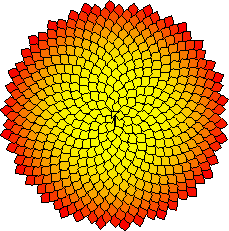Computer model explaines alluring plant shapes

Flowers are innately beautiful to the human eye, but how does a sunflower achieve its stunning disc of intersecting spirals or a daisy its delicate symmetry?
That was the question tackled by University of Calgary computer scientists, who have answered one of biology's enduring questions with an animated model that provides the most detailed simulation of how plants grow into recognizable shapes.
In the article "A plausible model of phyllotaxis" published in this week's edition of the Proceedings of the National Academy of Sciences, University of Calgary PhD student Richard Smith and Computer Science professor Dr. Przemyslaw Prusinkiewicz, together with their collaborators from the Institute of Plant Science in Berne, Switzerland (Soazig Guyomarc'h, Therese Mandel, Didier Reinhardt, and professor Cris Kuhlemeier), present the first model to show how plants achieve phyllotaxis – the unique arrangement of lateral organs around a central axis that results in the spiral patterns seen in most plants – beginning at the molecular-level.
"Biologists have many theories about why phyllotaxis exists but have always wondered how it happens," said Smith. "This model is exciting because it proposes a mechanism that works and can be used to try and prove some of the biological theories about the growth process."
Smith and Prusinkiewicz worked with the botanists in Switzerland to create a three-dimensional simulation of plant growth at the microscopic scale, simulating cell division and showing how concentrations of the fundamental plant growth hormone auxin appear at regularly-spaced intervals. This creates the striking spiral patterns of seeds observed in sunflowers, daisies, and many other plants. Other patterns, such as branching at right angles observed in lilac branching, can be also be simulated using different parameter values.
The subject of the study was a plant called Arabidopsis, a small white-flowered plant that is to the world of botany what the fruit fly and white mouse are to zoology.
The scientists believe their model will enhance biological experiments by providing a tool botanists can use to complement and interpret their traditional laboratory experiments. It also promises to lead to accurate models of how other organisms, including animals, develop from primordial stem cells.
"This was a great example of the synergy you can have between biology and computer science and how the tools of one discipline can be used to answer questions in another," said Prusinkiewicz, who specializes in computer simulations and visualizations in plant biology. "
Source: University of Calgary





















